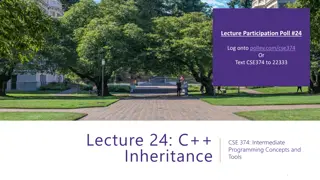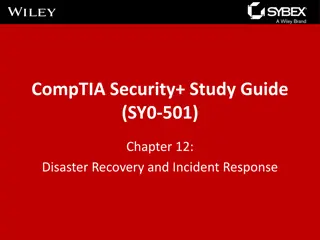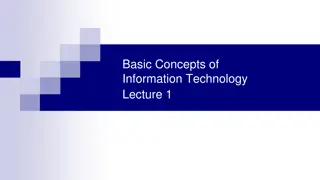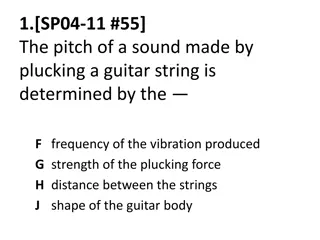
Understanding N.IF Navigation and Ancillary Information Facility
Explore the fundamental concepts of N.IF Navigation and Ancillary Information Facility in a tutorial introducing key terminology and concepts. Learn about time systems, atomic time, and astronomical time to enhance your understanding. Discover the significance of epochs, clocks, and coordinate systems in navigational information.
Download Presentation

Please find below an Image/Link to download the presentation.
The content on the website is provided AS IS for your information and personal use only. It may not be sold, licensed, or shared on other websites without obtaining consent from the author. If you encounter any issues during the download, it is possible that the publisher has removed the file from their server.
You are allowed to download the files provided on this website for personal or commercial use, subject to the condition that they are used lawfully. All files are the property of their respective owners.
The content on the website is provided AS IS for your information and personal use only. It may not be sold, licensed, or shared on other websites without obtaining consent from the author.
E N D
Presentation Transcript
N IF Navigation and Ancillary Information Facility Fundamental Concepts April 2023
N IF Topics Navigation and Ancillary Information Facility Preface Time Reference Frames Coordinate Systems Positions and States Aberration Corrections 2 Fundamental Concepts
N IF Preface Navigation and Ancillary Information Facility This tutorial introduces terminology and concepts used in the later SPICE tutorials. Some of this material is more difficult than what follows in later presentations. A complete understanding of this material is not essential in order to use SPICE. Still, we think this information may be helpful, so on we go! 3 Fundamental Concepts
N IF Time Navigation and Ancillary Information Facility An epoch is an instant in time specified by some singular event Passage of a star across your zenith meridian Eclipse of a spacecraft signal as it passes behind a solid body Clocks Clocks count epochs specified by events such as: regular oscillations of a pendulum, quartz crystal, or electromagnetic radiation from a specified source, measured from an agreed upon reference epoch. Careful specification of epochs using clocks requires reference to the particular clock and the location of that clock. Time Systems Are agreed upon standards for naming epochs, measuring time, and synchronizing clocks 4 Fundamental Concepts
N IF Atomic Time and UTC Navigation and Ancillary Information Facility International Atomic Time (TAI) Statistical time scale Based on data from ~200 atomic clocks in over 50 national laboratories Maintained by Bureau International des Poids et Mesures (BIPM) Unit is the SI (System International) second duration of 9192631770 periods of the radiation corresponding to the transition between two hyperfine levels of the ground state of the cesium 133 atom TAI is expressed as a count of atomic seconds past the astronomically determined instant of midnight 1 Jan 1958 00:00:00 Coordinated Universal Time (UTC) Civil Time at Greenwich England (~GMT) Usual Calendar Formats plus Hour:Minute:Second.fraction Relationship between TAI and UTC UTC + 10 seconds + number of leap seconds = TAI Valid only after Jan 01, 1972 5 Fundamental Concepts
N IF Astronomical Time UT1 Navigation and Ancillary Information Facility Astronomical Time (UT1) is an hour representation of the angle between the Greenwich zenith meridian and the location of the computed mean sun. Used prior to atomic time for civil time keeping UT1 6 Fundamental Concepts
N IF Tying UTC to Earth s Rotation (UT1) Navigation and Ancillary Information Facility Ideally, UTC noon and astronomical noon at Greenwich (UT1) should occur simultaneously. However, the earth s rotation is not uniform. Eventually, UTC noon and astronomical noon at Greenwich get out of sync. UTC UT1 When the mismatch becomes greater than 0.9 atomic seconds, a leap second is added to (or removed from) the end of a designated UTC day normally either June 30 or December 31. The variations in the earth s rotation that cause leap seconds to be needed are not predictable. 7 Fundamental Concepts
N IF Leapseconds (+ and -) Navigation and Ancillary Information Facility Sequence with a Positive Leapsecond 1998 Dec 31 23:59:58.0 1998 Dec 31 23:59:59.0 1998 Dec 31 23:59:60.0 1999 Jan 01 00:00:00.0 1999 Jan 01 00:00:01.0 Sequence with a Negative Leapsecond 1998 Dec 31 23:59:57.0 1998 Dec 31 23:59:58.0 1999 Jan 01 00:00:00.0 1999 Jan 01 00:00:01.0 Normal sequence of UTC time tags 1998 Dec 31 23:59:58.0 1998 Dec 31 23:59:59.0 1999 Jan 01 00:00:00.0 1999 Jan 01 00:00:01.0 Leap seconds complicate the task of finding the duration between two UTC epochs: You need to know when past leap seconds occurred to compute durations defined by pairs of past UTC epochs. Durations defined by pairs of future UTC epochs are indeterminate if leap seconds could occur in the interim. 8 Fundamental Concepts
N IF Barycentric Dynamical Time Navigation and Ancillary Information Facility Barycentric Dynamical Time (TDB) and Ephemeris Time (ET) are synonyms in SPICE documentation. TDB is a mathematical ideal used in the equations of motion. used as the independent time variable for many SPICE subroutine interfaces. related to Barycentric Coordinate Time (TCB) by an offset and a scale factor. TDB advances on average at very close to the same rate as TAI---the difference is nearly periodic. 9 Fundamental Concepts
N IF Terrestrial Dynamical Time Navigation and Ancillary Information Facility Terrestrial Dynamical Time (TDT) TDT is the Ideal Time (proper time) on Earth at sea level TDT = TAI + 32.184 seconds The IAU has adopted the name Terrestrial Time (TT) But this is called TDT throughout SPICE documentation TDB and TDT have nearly the same reference epoch (approximately 1 Jan 2000, 12:00:00 at Greenwich England), called J2000. TDB and TDT advance at different rates. Variations are small: ~ 1.6 milliseconds Variations are almost periodic with a period of 1 sidereal year (to first order) Variations are due to relativistic effects TDB = TDT + 0.001657 sin( E + 0.01671sin(E) ) Use of TDT in the SPICE system is quite limited. SCLK kernels Duration computations involving UTC 10 Fundamental Concepts
N IF Offsets between Time Systems Navigation and Ancillary Information Facility Difference between seconds past J2000 in a given time system and TDB seconds past J2000 TDB. Systems used for comparison are TDT, TAI, and UTC: TDT-TDB Magnified by 1000 As magnified amplitude views show, slopes are actually non-zero and non- constant: clocks in different time systems generally run at slightly different rates, and the differences in rates may be time-varying. TAI-TDB Actual amplitude of periodic term = ~1.6e-3 seconds Magnified by 1000 Differences at TDB = J2000 are non-zero: the epoch J2000 = 2000 JAN 1 12:00:00 in different time systems occurs at different TDB times. UTC-TDB Magnified by 1000 11 Fundamental Concepts
N IF Spacecraft Clocks Navigation and Ancillary Information Facility Spacecraft have onboard clocks to control scheduling of observations, maneuvers, attitude adjustments, etc. Used to time stamp data Fundamental unit of time is the tick Smallest increment possible for a spacecraft clock Nominal tick duration is spacecraft clock dependent Spacecraft clock time is a count of ticks since some reference tick. The duration of the tick drifts with respect to other time systems because spacecraft clocks are not very stable 12 Fundamental Concepts
N IF More about Spacecraft Clocks Navigation and Ancillary Information Facility SCLK string formats vary from one spacecraft clock to the next. Cassini: Maximum reading for partition 1 = 1/4294967295.255 Partition number: 1 Seconds: 4294967295 Ticks (for Cassini, unit = 1/256 second): 255 Galileo: Maximum reading for partition 1 = 1/16777215:90:09:07 Partition number: 1 "RIM" count (unit = 60 2/3 seconds): 16777215 "Mod 91" count (unit = 2/3 second): 90 "RTI" count (unit = 1/15 second): 9 "Mod 8" count (unit = 1/120 second): 7 The format of spacecraft clock and the relationship between tick count and other time systems (usually UTC) is captured in a SPICE SCLK kernel 13 Fundamental Concepts
SPICE Definitions: N IF Reference Frames & Coordinate Systems Navigation and Ancillary Information Facility A reference frame is an ordered set of three mutually orthogonal (possibly time dependent) unit- length direction vectors, coupled with a location called the frame s center or origin. SPICE documentation frequently uses the shorthand frame instead of reference frame. The ordered set of axes of a reference frame is also called a basis. A coordinate system specifies the method of locating a point within a reference frame. Two examples of coordinate systems Cartesian coordinates Spherical coordinates 14 Fundamental Concepts
N IF Reference Frame Center Navigation and Ancillary Information Facility A reference frame s center is an ephemeris object whose location is coincident with the origin (0, 0, 0) of the frame. The center of the IAU_<body> frame is center of mass of <body>. The center of any inertial frame is (in SPICE) the solar system barycenter. True even for frames naturally associated with accelerated bodies, such as MARSIAU. A frame s center plays little role in specification of states Origin cancels out when doing vector arithmetic Whether positions of objects A and B are specified relative to centers C1 or C2 makes no difference: (A C1) ( B C1 ) = ( A C2 ) ( B C2 ) = A B But the center *is* used in computing light time to centers of non-inertial frames When the aberration-corrected state of Titan as seen from the Cassini orbiter is computed in the body-fixed IAU_Titan frame, light time is computed from Titan s center to the Cassini orbiter, and this light time is used to correct both the state and orientation of Titan. (Light time and aberration corrections are discussed later on.) 15 Fundamental Concepts
N IF Types of Reference Frames Navigation and Ancillary Information Facility Inertial Non-rotating With respect to fixed stars Non-accelerating origin Velocity is typically non-zero; acceleration is negligible Examples: J2000 (also called ICRF), B1950 Non-Inertial Examples Body-fixed Centered at body center Topocentric Instrument Dynamic frames For example, frames defined by time-dependent vectors 16 Fundamental Concepts
N IF J2000 Frame Navigation and Ancillary Information Facility The J2000* (aka EME2000) frame definition is based on the earth s equator and equinox, determined from observations of planetary motions, plus other data. Z is normal to the mean equator of date at epoch J2000 TDB, which is approximately Earth s spin axis orientation at that epoch. (J2000 TDB is 2000 JAN 01 12:00:00 TDB, or JD 2451545.0 TDB). ZJ2000 Equatorial plane Plane normal to the earth s spin axis, Z Ecliptic plane Plane defined by movement of the earth around the sun YJ2000 Y = Z cross X Intersection of equatorial and ecliptic planes, called vernal equinox XJ2000 *Caution: The name J2000 is also used to refer to the zero epoch of the ephemeris time system (ET, also known as TDB). 17 Fundamental Concepts
N IF The ICRF Frame Navigation and Ancillary Information Facility The ICRF* frame is defined by the adopted locations of 295 extragalactic radio sources Z Solar System Barycenter Y X *ICRF = International Celestial Reference Frame The ICRF is managed by the International Earth Rotation Service (IERS) 18 Fundamental Concepts
N IF J2000 vs. ICRF Navigation and Ancillary Information Facility The realization of ICRF was made to coincide almost exactly with the J2000 frame. The difference is very small a rotation of less than 0.1 arc second These two frame names are treated synonymously in SPICE In reality, any SPICE data said to be referenced to the J2000 frame are actually referenced to the ICRF frame For historical and backwards compatibility reasons, only the name J2000 is recognized by SPICE software as a frame name not ICRF No transformation is required to convert SPICE state vectors or orientation data from the J2000 frame to the ICRF. ICRF = International Celestial Reference Frame, defined by the IERS IERS = International Earth Rotation Service 19 Fundamental Concepts
N IF Body-fixed Frames Navigation and Ancillary Information Facility Body-fixed frames are tied to a named body and rotate with it The most common names, those for planets, satellites, the sun, and a few asteroids and comets, are hard-coded in SPICE software Frame name style is IAU_body name Examples: IAU_MARS, IAU_SATURN To see all such names, see: Frames Required Reading document, or Latest generic PCK file The rotation state (the orientation and angular velocity at time ? ?) is usually determined using a SPICE text PCK containing data published by the IAU The earth and moon are special cases! IAU_EARTH and IAU_MOON both exist but generally should NOT be used See the SPICE tutorial named lunar- earth_pck-fk for the best frames to be used for those bodies On very rare occasions a CK is used to provide a body s rotation state Z Y Body-fixed X 20 Fundamental Concepts
N IF Topocentric Frames Navigation and Ancillary Information Facility z points up Topocentric frames are attached to a surface Z-axis is parallel to the gravity gradient or orthogonal to reference spheroid Position Vector y points West x points North Azimuth (increases in clockwise direction, measured from +x axis) Elevation (angle between vector and x-y plane) Orthogonal projection of position vector onto x-y plane One example of a topocentric frame. There are other types of topocentric frames: for example, the z-axis could point down, the x- axis North, and the y-axis East. 21 Fundamental Concepts
N IF Coordinate System Conventions - 1 Navigation and Ancillary Information Facility Planetocentric coordinate systems For planets and their satellites the +Z axis (+90 LAT) always points to the north side of the invariable plane (the plane whose normal vector is the angular momentum vector of the solar system) Planetocentric longitude increases positively eastward Planetocentric latitude increases positively northward (also known as latitudinal) Z Dwarf planets*, asteroids and comets spin in the right hand sense about their positive pole. What the IAU now calls the positive pole is still referred to as the north pole in SPICE documentation. The positive pole may point above or below the invariable plane of the solar system (see above). This revision by the IAU Working Group (2006) inverts what had been the direction of the north pole for Pluto, Charon and Ida. Planetocentric routines are RECLAT/ LATREC, RADREC/RECRAD, DRDLAT/DLATDR *The dwarf planets are: Ceres, Eris, Haumea, Makemake, Pluto Y X 22 Fundamental Concepts
N IF Coordinate System Conventions - 2 Navigation and Ancillary Information Facility Planetodetic coordinate systems Planetodetic longitude is planetocentric longitude increases positively eastward Planetodetic latitude Tied to a reference ellipsoid For a point on a reference ellipsoid, the angle measured from the X-Y plane to the surface normal at the point of interest. For other points, equals latitude at the nearest point on the reference ellipsoid Latitude increases positively in the +Z direction +Z is defined the same as for planetocentric coordinates Planetodetic routines are RECGEO/GEOREC, DRDGEO/DGEODR Z Y X 23 Fundamental Concepts
N IF Coordinate System Conventions - 3 Navigation and Ancillary Information Facility Planetographic coordinate systems For planet and satellite planetographic coordinate systems: Planetographic latitude is planetodetic latitude Planetographic longitude is usually defined such that the sub-observer longitude increases with time as seen by a distant, fixed observer in an inertial reference frame The earth, moon and sun are exceptions; planetographic longitude is positive east by default Planetographic routines are PGRREC/RECPGR Z Spin direction . Y For dwarf planets, asteroids and comets: There are multiple, inconsistent standards! (USNO, IAU, PDS) NAIF strongly suggests you use only planetocentric or planetodetic coordinates Planetocentric routines are RECLAT/ LATREC, RADREC/RECRAD, DRDLAT/DLATDR Planetodetic routines are RECGEO/GEOREC, DRDGEO/DGEODR X Distant Observer 24 Fundamental Concepts
N IF State Vectors Navigation and Ancillary Information Facility The state of an object is its position and velocity relative to a second object In SPICE, these objects are often referred to as target and observer or center E.g. Saturn relative to Saturn barycenter; Titan relative to Huygens probe A state is always given in the TDB time system (also known as ET) In the SPK subsystem a state is a six dimensional vector First three components are Cartesian position: x, y, z Second three components are Cartesian velocity: dx/dt, dy/dt, dz/dt Units are km, km/sec A state is specified relative to a reference frame 25 Fundamental Concepts
N IF Transforming States Navigation and Ancillary Information Facility To perform algebraic operations on states they must be in the same reference frame. Position-only frame transformations require only a rotation* matrix given as a function of time. PB(t) = RA to B(t) PA(t) Position and velocity frame transformations require that we differentiate the above equation dPB(t) /dt = dRA to B(t)/dt PA(t) + RA to B(t) d PA(t)/dt We can use a 6x6 matrix to combine these two transformations into a single equation * Assuming both frames are right-handed 26 Fundamental Concepts
N IF Transforming States Navigation and Ancillary Information Facility SB(t) = TA to B(t)SA(t) ( where dPi(t)/dt i = A or B ) Pi(t) Si(t) = and ( ) RA to B(t) 0 TA to B(t) = dRA to B(t)/dt RA to B(t) The SPICELIB routines SXFORM and PXFORM return state transformation and position transformation matrices respectively. 27 Fundamental Concepts
N IF Aberration Corrections: Introduction Navigation and Ancillary Information Facility Within the SPICE system, aberration corrections are adjustments made to state vectors and time- dependent reference frames to accurately reflect the apparent as opposed to the actual state and attitude of a target object as seen from a specified observer at a specified time. Actual, uncorrected states from an ephemeris are called geometric states. When computing state vectors, SPICE users may request geometric or aberration-corrected states. Aberration corrections are needed to accurately answer questions such as: In which direction must a remote sensing instrument be pointed to observe a target of interest? For a given pointing direction and observation time, what target body surface location would be observed by a remote sensing instrument? In which direction must an antenna be pointed to transmit a signal to a specified target? 28 Fundamental Concepts
N IF Computing Aberration-corrected States Navigation and Ancillary Information Facility In order to compute an aberration-corrected state, the state vectors used in the computation must all be chained back to the Solar System Barycenter Saturn + Cassini spacecraft during interplanetary cruise The aberration-corrected red vector cannot be computed unless all three green vectors are available. Solar System Barycenter + Sun 29 Fundamental Concepts
N IF Example: Predicted vs Actual Photo Navigation and Ancillary Information Facility We compare the predicted appearance of a photograph from an optical camera against the actual photograph. We show three predictions derived using different aberration corrections: NONE, LT ("light time only"), and LT+S ("light time plus stellar aberration"). For each prediction, we use red overlays to indicate the expected location in the photo of the images of an extended target body (for example, a natural satellite), of features on the surface of the target body, and of a star. LT+S NONE LT Predicted images using light time and stellar aberration- corrected target position, light time-corrected target orientation, and stellar aberration-corrected star direction vector Predicted images using uncorrected target position and orientation and uncorrected star direction vector Predicted images using light time-corrected target position and orientation and uncorrected star direction vector 30 Fundamental Concepts
N IF Prediction Without Corrections Navigation and Ancillary Information Facility Predicted target body, surface feature, and star image locations (in red). Actual locations are in blue and black. Body motion relative to solar system barycenter Actual star image Actual body image Using geometric target positions, target images in photos or other remote-sensing observations don t appear at their predicted locations. 31 Fundamental Concepts
N IF Light Time Corrections Navigation and Ancillary Information Facility Target s velocity vector Target s angular velocity vector Target s (geometric) position and orientation at time ET Target s position and orientation at time ET-LT (light time corrected position and orientation) Target travels this path (along the black arc) in LT seconds Note: The angular separation of the geometric and light time corrected positions as seen by the observer has been exaggerated for readability. Light travels this path in LT seconds Observer s position at time ET At time ET, the observer s camera records photons emitted from the target at time ET-LT, where LT is the one-way light time. The camera "sees" the target's position and orientation at ET-LT. 32 Fundamental Concepts
N IF Prediction Using Light Time Corrections Navigation and Ancillary Information Facility Predicted target body, surface feature, and star image locations (in red). Actual locations are in blue and black. Body motion relative to solar system barycenter Actual star image Actual body image Using the light time corrected target position and orientation, the predicted locations in the photo of the target image and surface features have changed, but the accuracy of the prediction may still be poor. 33 Fundamental Concepts
N IF Stellar Aberration Correction Navigation and Ancillary Information Facility Target s apparent position and orientation Target s position and orientation at time ET. This position is called the geometric or uncorrected position. Target s position and orientation at time ET-LT (light time corrected position and orientation) Note: The angular separation of the geometric, light time corrected, and apparent positions as seen by the observer has been exaggerated for readability. Velocity component orthogonal to observer-target position To the observer, light appears to travel this path Observer s velocity relative to Solar System Barycenter Observer s position at time ET At time ET, the observer s camera records photons emitted from the target at time ET-LT, where LT is the one-way light time. The vector from the observer at ET to the location of the target at ET-LT is displaced by a physical phenomenon called stellar aberration. The displaced vector yields the apparent position of the target. 34 Fundamental Concepts
N IF Prediction Using "LT+S" Corrections Navigation and Ancillary Information Facility Actual star image Actual body image Predicted target body, surface feature, and star image locations (in red) Using the light time and stellar aberration-corrected target position, light time- corrected target orientation, and stellar aberration-corrected star direction, we obtain a significantly improved image location predictions. Remaining prediction errors may be due to, among other causes, pointing error, spacecraft and target ephemeris errors, and timing errors. 35 Fundamental Concepts
N IF Newtonian Stellar Aberration Effect Navigation and Ancillary Information Facility Camera Photon emission from Target at ET - LT Photon reception at ET Photon path length = c * LT V = observer velocity component orthogonal to radiation path. We ignore parallel velocity component because it has negligible effect on photon path geometry. Observer path length = V*LT Observer at ET-LT Solar System Barycentric Reference Frame Photon emission from Target at ET - LT Component of photon path orthogonal to V. Length ~= c * LT Apparent direction to target Component of photon path parallel to V. Length ~= V*LT -Observer velocity component orthogonal to radiation path Photon path in observer frame Camera Photon reception at ET Stellar aberration angle dtheta sin(dtheta) = v/c +O(v2/c2) Observer Reference Frame 36 Fundamental Concepts
N IF Effect of Aberration Corrections - 1 Navigation and Ancillary Information Facility Angular offsets between corrected and uncorrected position vectors over the time span 2004 Jan 1 2005 Jan1 Mars as seen from MEX: LT+S vs NONE: .0002 to .0008 degrees LT vs NONE: .0006 to .0047 degrees Earth as seen from MEX: LT+S vs NONE: .0035 to .0106 degrees LT vs NONE: .0000 to .0057 degrees MEX as seen from Earth: LT+S vs NONE: .0035 to .0104 degrees LT vs NONE: .0033 to .0048 degrees Sun as seen from Mars: LT+S vs NONE: .0042 to .0047 degrees LT vs NONE: .0000 to .0000 degrees 37 Fundamental Concepts
N IF Effect of Aberration Corrections - 2 Navigation and Ancillary Information Facility Angular offsets between corrected and uncorrected position vectors over the time span 2004 Jan 1 2008 Jan1 Saturn as seen from CASSINI: LT+S vs NONE: .0000 to .0058 degrees LT vs NONE: .0001 to .0019 degrees Titan as seen from CASSINI: LT+S vs NONE: .0000 to .0057 degrees LT vs NONE: .0000 to .0030 degrees Earth as seen from CASSINI: LT+S vs NONE: .0000 to .0107 degrees LT vs NONE: .0000 to .0058 degrees CASSINI as seen from Earth: LT+S vs NONE: .0000 to .0107 degrees LT vs NONE: .0000 to .0059 degrees Sun as seen from CASSINI: LT+S vs NONE: .0000 to .0059 degrees LT vs NONE: .0000 to .0000 degrees 38 Fundamental Concepts
N IF Effect of Aberration Corrections - 3 Navigation and Ancillary Information Facility Angular offsets between corrected and uncorrected position vectors over the time span 2025 Apr 1 2028 May 23 Earth as seen from Mercury: LT+S vs NONE: .0001 to .0168 degrees LT vs NONE: .0050 to .0058 degrees Mercury as seen from Earth: LT+S vs NONE: .0001 to .0168 degrees LT vs NONE: .0000 to .0112 degrees Mercury as seen from MPO: LT+S vs NONE: .0004 to .0006 degrees LT vs NONE: .0000 to .0113 degrees MPO as seen from Earth: LT+S vs NONE: .0000 to .0169 degrees LT vs NONE: .0000 to .0113 degrees Earth as seen from MPO: LT+S vs NONE: .0000 to .0169 degrees LT vs NONE: .0050 to .0058 degrees 39 Fundamental Concepts
N IF Effect of Aberration Corrections - 4 Navigation and Ancillary Information Facility Range differences between position vectors computed using LT+S vs CN+S corrections, over the time span 2025 Apr 1 2028 May 23 Earth as seen from Mercury: LT+S vs CN+S: 0.0000 to 0.6760 km Mercury as seen from Earth: LT+S vs CN+S: 0.0000 to 5.6949 km Mercury as seen from MPO: LT+S vs CN+S: 0.0000 to 0.0001 km MPO as seen from Earth: LT+S vs CN+S: 0.0000 to 5.8694 km Earth as seen from MPO: LT+S vs CN+S: 0.0000 to 0.6760 km 40 Fundamental Concepts






















